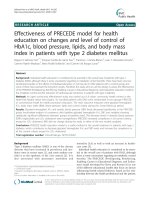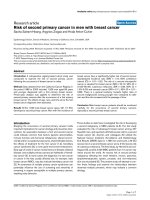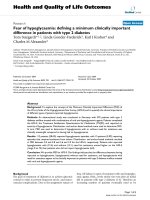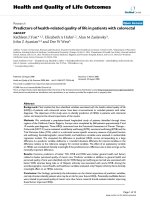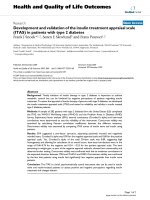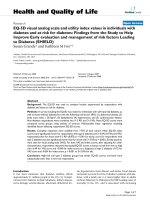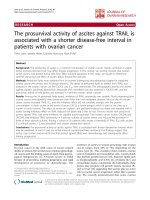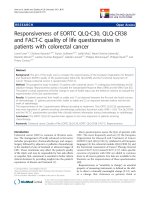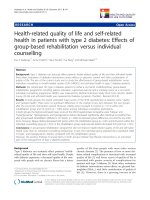Risk of bladder cancer in patients with diabetes mellitus: An updated meta-analysis of 36 observational studies
Bạn đang xem bản rút gọn của tài liệu. Xem và tải ngay bản đầy đủ của tài liệu tại đây (827.5 KB, 8 trang )
Zhu et al. BMC Cancer 2013, 13:310
/>
RESEARCH ARTICLE
Open Access
Risk of bladder cancer in patients with diabetes
mellitus: an updated meta-analysis of 36
observational studies
Zhaowei Zhu1†, Xianjin Wang1†, Zhoujun Shen1*, Yingli Lu2*, Shan Zhong1 and Chen Xu3,4
Abstract
Background: Increasing evidence suggests that a history of diabetes mellitus (DM) may be associated with an
increased risk of bladder cancer. We performed a systematic review with meta-analysis to explore this relationship.
Methods: We identified studies by a literature search of Medline (from 1 January 1966) and EMBASE (from 1
January 1974), through 29 February 2012, and by searching the reference lists of pertinent articles. Summary relative
risks (RRs) with corresponding 95% confidence intervals (CIs) were calculated with a random-effects model.
Results: A total of 36 studies (9 case–control studies, 19 cohort studies and 8 cohort studies of patients with diabetes)
fulfilled the inclusion criteria. Analysis of all studies showed that DM was associated with an increased risk of bladder
cancer (the summary RR = 1.35, 95% CI 1.17–1.56, p < 0.001, I2 = 94.7%). In analysis stratified by study design, diabetes was
positively associated with risk of bladder cancer in case–control studies (RR = 1.45, 95% CI 1.13-1.86, p = 0.005, I2 = 63.8%)
and cohort studies (RR = 1.35, 95% CI 1.12-1.62, p < 0.001, I2 = 94.3%), but not in cohort studies of diabetic patients (RR =
1.25, 95% CI 0.86–1.81, p < 0.001, I2 = 97.4%). The RRs of bladder cancer were 1.38 (1.08-1.78) for men and 1.38 (0.90-2.10)
for women with diabetes, respectively. Noteworthy, the relative risk of bladder cancer was negatively correlated with the
duration of DM, with the higher risk of bladder cancer found among patients diagnosed within less than 5 years.
Conclusions: These findings support the hypothesis that men with diabetes have a modestly increased risk of bladder
cancer, while women with diabetes were not the case.
Keywords: Diabetes, Bladder Cancer, Meta-analysis
Background
Bladder cancer represents the first and second most
common genitourinary malignancy in China and the
USA, respectively. Based on incidence and mortality data
from several agencies, the American Cancer Society estimates that 73,510 new bladder cancer cases and 14,880
deaths from bladder cancer are projected to occur in the
United States in 2012 [1]. To explore the effective tools
for prevention of bladder cancer, great investment has
been made to gain new insight into how environmental
* Correspondence: ;
†
Equal contributors
1
Department of Urology, Ruijin Hospital, School of Medicine, Shanghai
Jiaotong University, Shanghai, China
2
Institute and Department of Endocrinology and Metabolism, Shanghai
Ninth People's Hospital, School of Medicine, Shanghai Jiaotong University,
Shanghai, China
Full list of author information is available at the end of the article
and genetic factors influence the development of bladder
cancer. To date, several risk factors, such as paint, smoking and human papillomavirus infection, have been implicated in urinary bladder carcinogenesis [2-4].
Diabetes mellitus (DM) is considered to be one of the
major public health challenges in both industrialized and
developing countries [5]. The relationship between DM
and malignancies has been investigated extensively; and
ample evidence indicates that individuals with diabetes
have increased risk of several malignancies, including
cancers of the colon and rectum [6]. A clarification of
the association between DM and cancer is important for
disease prevention and management.
Diabetes may also be a risk factor for bladder cancer,
but findings from epidemiological studies are inconsistent.
A previous meta-analysis of 16 studies (7 case–control
studies, 3 cohort studies and 6 cohort studies of patients
© 2013 Zhu et al.; licensee BioMed Central Ltd. This is an Open Access article distributed under the terms of the Creative
Commons Attribution License ( which permits unrestricted use, distribution, and
reproduction in any medium, provided the original work is properly cited.
Zhu et al. BMC Cancer 2013, 13:310
/>
Page 2 of 8
with diabetes) conducted in 2006 showed that diabetes
was associated with an increased risk of bladder cancer in
case–control studies and cohort studies, but not in cohort
studies of patients with diabetes. However, a publication
bias against studies with small sample sizes and against
reporting a low relative risk is possible, and may have
resulted in an overestimation of the relationship between
diabetes and bladder cancer [7]. Besides, most studies included in the meta-analysis were performed in Western
countries, and only one study was conducted in the Asian
population in Korea [8]. Thus, the association between
DM and bladder cancer in Asian population has not been
investigated extensively. Moreover, the association in different gender groups is worthy of investigation, but has
not been looked at.
Since the meta-analysis was published, a variety of relevant
studies on this association have also yielded inconsistent results. No association was found between DM and bladder
cancer in a prospective study of Swedish men [9]. However,
a case–control study in New England showed that history of
diabetes was related to an increased bladder cancer risk, and
the association was strongest in those who had diabetes for
the longest duration [10]. Currently, we aim to analyze this
relationship further by conducting an updated meta-analysis
of relevant studies. This updated analysis of 36 studies will
allow us to provide more precise risk estimates than the previous analysis. Furthermore, we also examined whether the
association between a history of DM and the risk of bladder
cancer differs according to various study characteristics.
odds ratio, or standardized incidence/mortality rate
(SIR/SMR) with their 95% confidence intervals (CIs), or
provided sufficient information to calculate them. In the
event of multiple publications from the same study
population, the most recent publication with the largest
number of bladder cancer cases was included in the
meta-analysis. We did not consider studies in which the
exposure of interest was type 1 diabetes, which was defined as early age (≤ 30 years) of diagnosis. Articles or
reports from non-peer-reviewed sources were not included in our analysis.
Methods
Statistical analysis
Search strategy
We included in this meta-analysis studies reporting different measures of relative risks: rate ratio, hazard ratio
and SIR/SMR. In practice, these measures of effect yield
similar estimates of RR because the absolute risk of
bladder cancer is low. The variance of the log RR from
each study was calculated by converting the 95% CI to
its natural logarithm by taking the width of the CI and
dividing by 3.92. Summary relative risk estimates with
corresponding 95% CIs were derived using the method
of DerSimonian and Laird with the assumptions of a
random-effects model, which considers both withinstudy and between-study variations. When sex-specific
estimates were available, we first analyzed together (as
RR estimates for bladder cancer) and then separately (as
RR estimates for cancers of different gender group).
In assessing heterogeneity among studies, we used the
Cochran Q test and I2 statistics. These were used to test
whether the differences obtained between studies were due
to chance. For the Q statistic, a p value of less than 0.10
was used as an indication of the presence of heterogeneity;
for I2, a value >50% was considered a measure of severe
heterogeneity. To explore the potential heterogeneity between studies, we conducted analyses stratified by study
A computerized literature search was performed in
Medline (from 1 January 1966) and EMBASE (from 1
January 1974), through 29 February 2012, by two independent investigators. We searched the relevant studies
with the following text words and/or Medical Subject
Headings: ‘diabetes mellitus’, ‘diabetes’, ‘bladder cancer’,
‘urinary bladder neoplasms’, ‘transitional cell carcinoma
of the bladder’, and ‘epidemiologic studies’. The search
was restricted to articles published in English and
reporting on the association between diabetes and bladder cancer in humans. References of relevant review articles and trials were screened for relevant articles that
were not found through the database searches. Our systematic review was conducted according to the meta-analysis
of observational studies in epidemiology guidelines.
Selection criteria
In this meta-analysis, we included studies that fulfilled
the following criteria: (1) presented original data from
case-control or cohort studies; (2) one of the exposure
of interest was DM; (3) one of the outcome of interest
was bladder cancer; and (4) reported relative risk (RR),
Data extraction
Two investigators independently assessed and extracted
the data into a standardized data extraction form from
each publication. Disagreements were resolved by a third
author. We did not contact authors of the original studies in the case of missing data. Relevant data included
the first author’s last name, publication year, year of the
study conducted, study design, study location, source
population, sample size (cases and controls or cohort
size), measure of exposure and outcome, length of
follow-up (if applicable), variables adjusted in the analysis, and the risk estimates with corresponding 95% CIs.
If studies reported both incidence and mortality rate, we
extracted the incidence rate, as mortality rate could be
confounded by survival-related factors. From each study,
we extracted the RR estimate that was adjusted for the
greatest number of potential confounders.
Zhu et al. BMC Cancer 2013, 13:310
/>
design, gender, geographic region, publication year, and we
also evaluated the impact of adjustment for age, sex, smoking, alcohol consumption, body mass index (BMI),physical
activity on the association between diabetes and the risk of
bladder cancer. Studies which reported separate RRs for
mutually exclusive categories of duration since diabetes was
diagnosed (e.g. < 5 years, ≥5 years) were pooled separately
to examine how the strength of the association varied with
duration of diabetes.
Publication bias was evaluated using a funnel plot of a
trial’s effect size against the SE. Because funnel plots
have several limitations and represent only an informal
approach to detect publication bias, we further carried
out formal testing using the test proposed by the Begg’s
adjusted rank correlation test and by the Egger’s regression test [11,12]. All statistical analyses were performed
using STATA, version 11.0 (STATA, College Station, TX,
USA). A two-tailed p-value of less than 0.05 was considered to be statistically significant.
Results
Search results
We identified 286 potentially relevant articles (Figure 1).
After exclusion of duplicate references, none-relevant literature, and those that did not satisfy inclusion criteria,
36 candidate articles were considered for the metaanalysis, including nine case–control studies (Additional
file 1: Table S1) [10,13-20], 19 cohort studies (Additional
file 2: Table S2) [8,9,21-37] and eight cohort studies
(Additional file 3: Table S3) [38-45] of patients with diabetes using external population comparisons. Of these
studies, 12 studies were conducted in Europe, 13 in
North America, nine in Asia, and two in multiple countries. The study population in 31 studies consisted of
Page 3 of 8
men and women, four studies consisted entirely of men
and one study included women only. Among these 36
studies, 18 studies did not demonstrate a significantly increased risk of bladder cancer in patients with DM, and
the rest studies reported a significantly increased risk of
bladder cancer in individuals with diabetes. Potential
confounders were controlled in most of the studies, except in nine studies where the adjusted confounders
were not clearly indicated.
DM and risk of bladder cancer
As shown in Figure 2, the summary RR with 95% CI was
1.35 (95% CI, 1.17–1.56) in a random-effects model for
patients with diabetes, compared with individuals without DM. There was statistically significant heterogeneity
among these studies (Q = 660.30, P < 0.001, I2 = 94.7%).
In analysis stratified by study design, the summary RR
with 95% CI was 1.45 (95% CI, 1.13-1.86) and 1.35 (95%
CI, 1.35-1.62) in case–control and cohort studies, respectively. However, diabetes was not associated with
risk of bladder cancer in cohort studies of patients with
diabetes (RR = 1.25; 95% CI, 0.86–1.81). There was statistically significant heterogeneity among the case–control studies (Q = 22.13, p = 0.005, I2 = 63.8%), the
cohort studies (Q = 315.87, p < 0.001, I2 = 94.3%) and
the studies of patients with diabetes (Q = 264.47,
p < 0.001, I2 = 97.4%).
We also investigated the impact of confounding factors on the estimates of relative risk (Additional file 4:
Table S4). The summary estimates were significantly
higher for studies conducted in Asia and North America
(p < 0.05) than in Europe and for studies published in
2000 or later than for studies published before 2000 (p <
0.05). The summary estimates were lower for studies
that reported age-adjusted RRs than for those which did
not [summary RR (95% CI); 1.34 (1.18-1.51) versus 1.60
(1.53-1.67)]. The summary estimates were higher for
studies that reported smoking-adjusted RRs than for
those which did not [summary RR (95% CI); 1.32 (1.24–
1.39) versus 1.26 (0.99–1.60)]. There was statistically significant heterogeneity within most subgroups.
DM and incidence of bladder cancer by sex
Figure 1 Flow chart on the articles selection process.
Fourteen studies provided results on cancer incidence or
mortality specific for gender; Additional four studies
consisted entirely of men and one study consisted entirely of women. In stratified analyses by gender, a significantly stronger positive association was observed in
men (summary RRs, 1.38; 95% CI, 1.08-1.78; p < 0.001
for heterogeneity). However, diabetes was not associated
with an increased risk of bladder cancer in women
(summary RRs, 1.38; 95% CI, 0.90-2.10; p < 0.001 for
heterogeneity) (Figure 3).
Zhu et al. BMC Cancer 2013, 13:310
/>
Page 4 of 8
Figure 2 Forest plots of bladder cancer incidence/standard incidence rate associated with diabetes.
Duration of DM and risk of bladder cancer
The temporal sequence between diabetes and bladder
cancer has not always been clear. Three studies in
our meta-analysis presented with RRs for duration of
diabetes [10,24,33]. However, duration of diabetes
was not similar across the studies. Thus, we categorized the patients into two groups, those with diabetes of less than 5 years and those with diabetes of
5 years or more. Combining these studies according
to diabetes duration, we found that individuals with
the shorter duration of diabetes (< 5 years) had
higher risk of developing bladder cancer than
individuals who had duration of diabetes more than 5
years [summary RR, 95% CI; 1.52 (1.05–2.21) versus
1.08 (0.91–1.28)].
Publication bias
There was no funnel plot asymmetry for the association between DM and risk of bladder cancer. P values
for Begg’s adjusted rank correlation test was 0.989 and
the Egger’s regression asymmetry test was 0.284,
suggesting a low probability of publication bias
(Figure 4).
Zhu et al. BMC Cancer 2013, 13:310
/>
Page 5 of 8
Figure 3 Forest plots of bladder cancer incidence/standard incidence rate by sex associated with diabetes.
Discussion
In this meta-analysis, we found that compared with nondiabetics or general population, individuals with diabetes
may have more than 35% increased risk of bladder cancer. However, there were differences in the summary RR
among different study designs. Whereas diabetes was
positively associated with an increased risk of bladder
cancer in case–control and cohort studies, the summary
estimate in cohort studies of patients with diabetes did
not indicate an excess risk of bladder cancer in these
cases compared with the general population.
The strength of the study includes that, on an international scale, there are far more individuals with diabetes
in our study. After adjustment for important covariates,
our study extends previous meta-analysis by providing a
more precise estimate of the association between diabetes
and bladder cancer risk (based on 36 studies). Despite
similar summary RRs between women and men, the positive association was only observed in men, and was independent of BMI, alcohol consumption, smoking status
and physical activity. Lorente and colleagues found that
transitional cell carcinoma of the bladder was more frequent in males than females. However, never-smoker
women have larger and more aggressive tumors with a
higher frequency of muscle-invasive disease than male
never-smokers and equaling to male current-smokers [46].
Moreover, women also had higher risk of invasive bladder
cancer than men even they smoked comparable amount of
cigarettes as men [47]. Further studies are needed to confirm our findings and to understand the molecular pathways that might explain the gender-related differences.
Furthermore, the relationship between duration of exposure to diabetes and risk of bladder cancer could be
calculated by summing up data from different studies.
Zhu et al. BMC Cancer 2013, 13:310
/>
Page 6 of 8
Figure 4 Funnel plot of observational studies evaluating the association between diabetes and bladder cancer risk.
The current meta-analysis indicated that the risk of
bladder cancer was inversely associated with the duration of DM. There was a slightly increased risk which
did not reach statistical significance among individuals
with diabetes more than 5 years and an increased rate of
bladder cancer was observed in individuals with a
shorter duration of diabetes (< 5 years). This finding indicated that those with newly diagnosed diabetes should
be highly alert to bladder cancer development. However,
MacKenzie and colleagues found that compared with
those without diabetes, the risk of bladder cancer was
highest among those with diabetes of 16 years or more
[10]. It is worth noticing that only three studies in our
study presented with RRs for duration of diabetes
[10,24,33]. When the effect of diabetes was evaluated,
glucose-lowering therapies should be adjusted for, and
this was not done in most studies. With increasing diabetes duration, the impact of anti-diabetic drugs may set
in and influence the association. Thus, the long-term
risk of bladder cancer among patients with diabetes warrants further investigation.
In stratified analysis by geographic regions and publication year, we found that the association between DM and
bladder cancer was not significant for studies conducted
in Europe and for studies published from 1970–1999,
whereas studies from North American and Asia and studies published since 2000 showed significantly stronger risk
estimates. The regional and temporal differences are
perplexing. Many environmental and personal determinants are related, including : genetic factors, lifestyle (eating habits, physical activities, somatotype characteristics),
environmental factors (environmental pollution, stress, socioeconomic status ), public health services and so on.
With the gradual improvement of medical conditions,
early screening and diagnosis rates of DM and bladder
cancer are greatly improved. These factors are all attributable to the regional and temporal differences. Our study
also has several potential limitations of the available data.
Thus, caution is needed when interpreting these results.
First, great heterogeneity existed in terms of geographical
region, study design, publication year, gender, duration of
diabetes and adjustment for confounders. Despite the use
of appropriate meta-analytic techniques with randomeffect models, we could not account for these differences.
The heterogeneity of risk estimates may be due to different mixtures of type 1 and type 2 participants with diabetes and different adjustment for potential confounders.
Moreover, some studies included both sexes, whereas
others included only men or only women. Nevertheless,
subgroup analyses showed that the risk estimate was robust across various quality components.
Second, because diabetes is an underdiagnosed disease,
some misclassification of exposure is likely, which would
tend to attenuate any true association between diabetes
and bladder cancer. In cohort studies of patients with
diabetes, the negative association between diabetes and
bladder cancer may be due to that the comparison group
includes individuals with diabetes, resulting in underestimation of the true effect size.
Third, recent studies have suggested that use of
pioglitazone (a common anti-diabetic drug) was associated with an increased incidence of bladder cancer
[48,49]. However, most studies included in this metaanalysis did not adjust for the effect of anti-diabetic
drugs, which may distort the true relationship between
diabetes and risk of bladder cancer.
Forth, confounding cannot be fully excluded as a potential explanation for the observed association, because
our analyses were based on observational studies. It is
generally accepted that diabetes and bladder cancer
Zhu et al. BMC Cancer 2013, 13:310
/>
share several common risk factors. Smoking has consistently been associated with increased risk of diabetes and
bladder cancer [50,51]. The relationship between diabetes and bladder cancer was stronger and statistically
significant when we restricted the analysis to those studies which controlled for smoking. When risk estimates
from the five studies that adjusted for physical activity
were combined, the association between diabetes and
bladder cancer was also stronger (RR 1.43) than the
overall result including all studies (RR 1.35). In the
current analysis, however, adjustment for a wide range
of potential confounders, including sex, BMI and alcohol
consumption, did not significantly alter the relationship
between diabetes and risk of bladder cancer.
Fifth, different study designs may have particular
methodological issues and constraints; yet, a common
theme with all is the potential for bias. Case–control
studies are susceptible to recall and selection biases
which could inflate the RRs. Cohort studies are prone to
be influenced by detection bias because patients with
diabetes are under increased medical surveillance. If
medical surveillance bias is present, bladder cancer
would tend to be diagnosed at an earlier stage in patients with diabetes than in those without diabetes.
Finally, inherent in any meta-analysis of published data
is the possibility of publication bias, that is small studies
with null results tend not to be published. However, the
results obtained from funnel plot analysis and formal
statistical tests did not provide evidence for such bias.
Although the absolute risks of bladder cancer are
low among individuals with diabetes, our results have
important clinical and public health significance. As a
serious and growing health problem in USA, DM
affects nearly 25.8 million people, 8.3% of the U.S.
population in 2010. In China, a cross-sectional study
from 2007 through 2008 involving a nationally representative sample of 46,239 adults, the age-standardized
prevalences of total diabetes and prediabetes were 9.7
and 15.5%, respectively [52]. Due to growing obesity
epidemic, the prevalence of diabetes will probably
increase and contribute to the development of bladder
cancer.
Conclusion
In conclusion, the results from this meta-analysis support an association between diabetes and increased risk
of bladder cancer. Further analysis indicates that the
positive association is only in men, but not in women.
More researches, both epidemiological and mechanistic,
are needed to further clarify the association between diabetes and risk of bladder cancer. Future work should
also focus on identifying the potential mechanisms
underlying this positive link.
Page 7 of 8
Additional files
Additional file 1: Table S1. Characteristics of nine case-control studies
of diabetes and bladder cancer risk.
Additional file 2: Table S2. Characteristics of 19 cohort studies of
diabetes and bladder cancer risk based on rate ratio and hazard ratio.
Additional file 3: Table S3. Characteristics of eight cohort studies of
diabetes and bladder cancer based on standardized incidence/mortality
ratio.
Additional file 4: Table S4. Subgroup analysis of relative risks for the
association between diabetes and bladder cancer risk.
Abbreviations
DM: Diabetes mellitus; CI: Confidence interval; RR: Relative risk;
SIR: Standardized incidence rate; SMR: Standardized mortality rate; MI: Body
mass index.
Competing interests
All authors declare that they have no competing interests.
Authors’ contributions
ZS and YL conceived the study. Data was acquired independently by SZ and
CX. ZZ undertook data analysis and interpretation. ZZ and WX prepared the
manuscript with contributions from all co-authors. All authors read and
approved the final manuscript.
Author details
1
Department of Urology, Ruijin Hospital, School of Medicine, Shanghai
Jiaotong University, Shanghai, China. 2Institute and Department of
Endocrinology and Metabolism, Shanghai Ninth People's Hospital, School of
Medicine, Shanghai Jiaotong University, Shanghai, China. 3Department of
Embryology and Histology, School of Medicine, Shanghai Jiaotong University,
Shanghai, China. 4Shanghai Key Laboratory of Reproductive Medicine, School
of Medicine, Shanghai Jiaotong University, Shanghai, China.
Received: 25 July 2012 Accepted: 3 June 2013
Published: 26 June 2013
References
1. Siegel R, Naishadham D, Jemal A: Cancer statistics, 2012. CA Cancer J Clin
2012, 62:10–29.
2. Guha N, Steenland NK, Merletti F, Altieri A, Cogliano V, Straif K: Bladder
cancer risk in painters: a meta-analysis. Occup Environ Med 2010,
67:568–573.
3. Freedman ND, Silverman DT, Hollenbeck AR, Schatzkin A, Abnet CC:
Association between smoking and risk of bladder cancer among men
and women. JAMA 2011, 306:737–745.
4. Li N, Yang L, Zhang Y, Zhao P, Zheng T, Dai M: Human papillomavirus
infection and bladder cancer risk: a meta-analysis. J Infect Dis 2011,
204:217–223.
5. Zimmet P, Alberti KG, Shaw J: Global and societal implications of the
diabetes epidemic. Nature 2001, 414:782–787.
6. Yuhara H, Steinmaus C, Cohen SE, Corley DA, Tei Y, Buffler PA: Is diabetes
mellitus an independent risk factor for colon cancer and rectal cancer.
Am J Gastroenterol 2011, 106:1911–1921. quiz 1922.
7. Larsson SC, Orsini N, Brismar K, Wolk A: Diabetes mellitus and risk of
bladder cancer: a meta-analysis. Diabetologia 2006, 49:2819–2823.
8. Jee SH, Ohrr H, Sull JW, Yun JE, Ji M, Samet JM: Fasting serum glucose
level and cancer risk in Korean men and women. JAMA 2005,
293:194–202.
9. Larsson SC, Andersson SO, Johansson JE, Wolk A: Diabetes mellitus, body
size and bladder cancer risk in a prospective study of Swedish men.
Eur J Cancer 2008, 44:2655–2660.
10. MacKenzie T, Zens MS, Ferrara A, Schned A, Karagas MR: Diabetes and risk
of bladder cancer: evidence from a case–control study in New England.
Cancer 2011, 117:1552–1556.
11. Begg CB, Mazumdar M: Operating characteristics of a rank correlation
test for publication bias. Biometrics 1994, 50:1088–1101.
Zhu et al. BMC Cancer 2013, 13:310
/>
12. Egger M, Davey SG, Schneider M, Minder C: Bias in meta-analysis detected
by a simple, graphical test. BMJ 1997, 315:629–634.
13. Ng Y, Husain I, Waterfall N: Diabetes mellitus and bladder cancer–an
epidemiological relationship. Pathol Oncol Res 2003, 9:30–31.
14. Risch HA, Burch JD, Miller AB, Hill GB, Steele R, Howe GR: Dietary factors
and the incidence of cancer of the urinary bladder. Am J Epidemiol 1988,
127:1179–1191.
15. O'Mara BA, Byers T, Schoenfeld E: Diabetes mellitus and cancer risk:
a multisite case–control study. J Chronic Dis 1985, 38:435–441.
16. Kantor AF, Hartge P, Hoover RN, Narayana AS, Sullivan JW, Fraumeni JF Jr:
Urinary tract infection and risk of bladder cancer. Am J Epidemiol 1984,
119:510–515.
17. La Vecchia C, Negri E, Franceschi S, D'Avanzo B, Boyle P: A case–control
study of diabetes mellitus and cancer risk. Br J Cancer 1994,
70:950–953.
18. Kravchick S, Gal R, Cytron S, Peled R, Weissman Y, Mukamel E, Koren R:
Increased incidence of diabetes mellitus in the patients with transitional
cell carcinoma of urinary bladder. Pathol Oncol Res 2001, 7:56–59.
19. Rousseau MC, Parent ME, Pollak MN, Siemiatycki J: Diabetes mellitus and
cancer risk in a population-based case–control study among men from
Montreal, Canada. Int J Cancer 2006, 118:2105–2109.
20. Kuriki K, Hirose K, Tajima K: Diabetes and cancer risk for all and specific
sites among Japanese men and women. Eur J Cancer Prev 2007,
16:83–89.
21. Tripathi A, Folsom AR, Anderson KE: Risk factors for urinary bladder
carcinoma in postmenopausal women. The Iowa Women’s Health Study.
Cancer 2002, 95:2316–2323.
22. Coughlin SS, Calle EE, Teras LR, Petrelli J, Thun MJ: Diabetes mellitus as a
predictor of cancer mortality in a large cohort of US adults.
Am J Epidemiol 2004, 159:1160–1167.
23. Li C, Balluz LS, Ford ES, Okoro CA, Tsai J, Zhao G: Association between
diagnosed diabetes and self-reported cancer among U.S. adults: findings
from the 2009 Behavioral Risk Factor Surveillance System. Diabetes Care
2011, 34:1365–1368.
24. Tseng CH: Diabetes and risk of bladder cancer: a study using the
National Health Insurance database in Taiwan. Diabetologia 2011,
54:2009–2015.
25. Marianne UY, Susan AO, Ulka BC, Carol EK: Incidence of cancer in a
population-based cohort of patients with type 2 diabetes. Diabetes
Metabolic Syndrome 2009, 3:12–16.
26. Woolcott CG, Maskarinec G, Haiman CA, Henderson BE, Kolonel LN:
Diabetes and urothelial cancer risk: the Multiethnic Cohort study.
Cancer Epidemiol 2011, 35:551–554.
27. Seshasai SR, Kaptoge S, Thompson A, Di AE, Gao P, Sarwar N, Whincup PH,
Mukamal KJ, Gillum RF, Holme I, et al: Diabetes mellitus, fasting glucose,
and risk of cause-specific death. N Engl J Med 2011, 364:829–841.
28. Inoue M, Iwasaki M, Otani T, Sasazuki S, Noda M, Tsugane S: Diabetes
mellitus and the risk of cancer: results from a large-scale populationbased cohort study in Japan. Arch Intern Med 2006, 166:1871–1877.
29. Ogunleye AA, Ogston SA, Morris AD, Evans JM: A cohort study of the risk
of cancer associated with type 2 diabetes. Br J Cancer 2009,
101:1199–1201.
30. Khan M, Mori M, Fujino Y, Shibata A, Sakauchi F, Washio M, Tamakoshi A:
Site-specific cancer risk due to diabetes mellitus history: evidence from
the Japan Collaborative Cohort (JACC) Study. Asian Pac J Cancer Prev
2006, 7:253–259.
31. Chung H: Diabetes and risk of death from cancer of the prostate, kidney,
and urinary bladder. Urology 2009, 74:S36–S37.
32. Wotton CJ, Yeates DG, Goldacre MJ: Cancer in patients admitted to
hospital with diabetes mellitus aged 30 years and over: record linkage
studies. Diabetologia 2011, 54:527–534.
33. Atchison EA, Gridley G, Carreon JD, Leitzmann MF, McGlynn KA: Risk of
cancer in a large cohort of U.S. veterans with diabetes. Int J Cancer 2011,
128:635–643.
34. Lee MY, Lin KD, Hsiao PJ, Shin SJ: The association of diabetes mellitus
with liver, colon, lung, and prostate canceris independent of
hypertension, hyperlipidemia, and gout in Taiwanese patients.
Metabolism 2012, 61:242–249.
35. Currie CJ, Poole CD, Jenkins-Jones S, Gale EA, Johnson JA, Morgan CL:
Mortality After Incident Cancer in People With and Without Type 2
Diabetes:Impact of metformin on survival. Diabetes Care 2012, 35:299–304.
Page 8 of 8
36. Liu X, Ji J, Sundquist K, Sundquist J, Hemminki K: The impact of type 2
diabetes mellitus on cancer-specific survival: A follow-upstudy in sweden.
Cancer 2012, 118:1353–1361.
37. Lam EK, Batty GD, Huxley RR, Martiniuk AL, Barzi F, Lam TH, Lawes CM,
Giles GG, Welborn T, Ueshima H, et al: Associations of diabetes mellitus
with site-specific cancer mortality in the Asia-Pacific region. Ann Oncol
2011, 22:730–738.
38. Kessler II: Cancer mortality among diabetics. J Natl Cancer Inst 1970,
44:673–686.
39. Adami HO, McLaughlin J, Ekbom A, Berne C, Silverman D, Hacker D,
Persson I: Cancer risk in patients with diabetes mellitus. Cancer Causes
Control 1991, 2:307–314.
40. Ragozzino M, Melton III LJ, Chu CP, Palumbo PJ: Subsequent cancer risk in
the incidence cohort of Rochester, Minnesota, residents with diabetes
mellitus. J Chronic Dis 1982, 35:13–19.
41. Wideroff L, Gridley G, Mellemkjaer L, Chow WH, Linet M, Keehn S,
Borch-Johnsen K, Olsen JH: Cancer incidence in a population-based
cohort of patients hospitalized with diabetes mellitus in Denmark.
J Natl Cancer Inst 1997, 89:1360–1365.
42. Verlato G, Zoppini G, Bonora E, Muggeo M: Mortality from site-specific
malignancies in type 2 diabetic patients from Verona(Italy). Diabetes Care
2003, 26:1047–1051.
43. Swerdlow AJ, Laing SP, Qiao Z, Slater SD, Burden AC, Botha JL, Waugh NR,
Morris AD, Gatling W, Gale EA, et al: Cancer incidence and mortality in
patients with insulin-treated diabetes: a UK cohort study. Br J Cancer
2005, 92:2070–2075.
44. Tseng CH, Chong CK, Tseng CP, Chan TT: Age-related risk of mortality
from bladder cancer in diabetic patients: a 12-year follow-up of a
national cohort in Taiwan. Ann Med 2009, 41:371–379.
45. Hemminki K, Li X, Sundquist J, Sundquist K: Risk of cancer following
hospitalization for type 2 diabetes. Oncologist 2010, 15:548–555.
46. Lorente JA, Bielsa O, Rijo E, Cortadellas R, Nohales G, Frances A, Juanpere N,
Lloreta J, Arango O: Clinical-pathological differences and smoking habit
depending on gender in a cohort of patients with transitional cell
carcinoma of the bladder: retrospective study. Arch Esp Urol 2011,
64:427–433.
47. Jiang X, Castelao JE, Yuan JM, Stern MC, Conti DV, Cortessis VK, Pike MC,
Gago-Dominguez M: Cigarette smoking and subtypes of bladder cancer.
Int J Cancer 2012, 130:896–901.
48. Lewis JD, Ferrara A, Peng T, Hedderson M, Bilker WB, Quesenberry CP Jr,
Vaughn DJ, Nessel L, Selby J, Strom BL: Risk of bladder cancer among
diabetic patients treated with pioglitazone: interim report of a
longitudinal cohort study. Diabetes Care 2011, 34:916–922.
49. Piccinni C, Motola D, Marchesini G, Poluzzi E: Assessing the association of
pioglitazone use and bladder cancer through drug adverse event
reporting. Diabetes Care 2011, 34:1369–1371.
50. Zeegers MP, Tan FE, Van Dorant E, DBPA: The impact of characteristics of
cigarette smoking on urinary tract cancer risk: a meta-analysis of
epidemiologic studies. Cancer 2000, 89:630–639.
51. Foy CG, Bell RA, Farmer DF, Goff DC Jr, Wagenknecht LE: Smoking and
incidence of diabetes among U.S. adults: findings from the Insulin
Resistance Atherosclerosis Study. Diabetes Care 2005, 28:2501–2507.
52. Yang W, Lu J, Weng J, Jia W, Ji L, Xiao J, Shan Z, Liu J, Tian H, Ji Q, et al:
Prevalence of diabetes among men and women in China. N Engl J Med
2010, 362:1090–1101.
doi:10.1186/1471-2407-13-310
Cite this article as: Zhu et al.: Risk of bladder cancer in patients with
diabetes mellitus: an updated meta-analysis of 36 observational studies.
BMC Cancer 2013 13:310.
